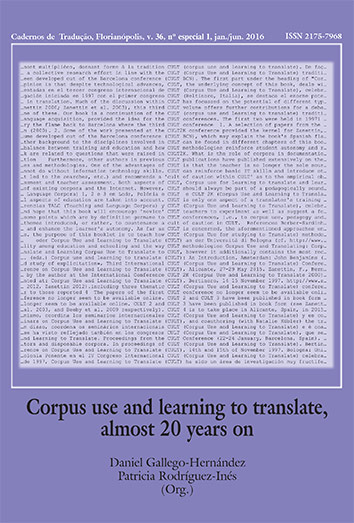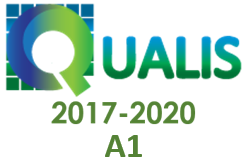Exploring theoretical functions of corpus data in teaching translation
DOI:
https://doi.org/10.5007/2175-7968.2016v36nesp1p177Resumo
As language referential data banks, corpora are instrumental in the exploration of translation solutions in bilingual parallel texts or conventional usages of source or target language in monolingual general or specialized texts. These roles are firmly rooted in translation processes, from analysis and interpretation of source text to searching for an acceptable equivalent and integrating it into the production of the target text. Provided the creative and not the conservative way be taken, validation or adaptation of target text in accordance with conventional usages in the target language also benefits from corpora. Translation teaching is not exploiting this way of translating that is common practice in the professional translation markets around the world. Instead of showing what corpus tools can do to translation teaching, we start our analysis with a common issue within translation teaching and show how corpus data can help to resolve it in learning activities in translation courses. We suggest a corpus-driven model for the interpretation of ‘business’ as a term and as an item in complex terms based on source text pattern analysis. This methodology will make it possible for teachers to explain and justify interpretation rules that have been defined theoretically from corpus data. It will also help teachers to conceive and non-subjectively assess practical activities designed for learners of translation. Corpus data selected for the examples of rule-based interpretations provided in this paper have been compiled in a corpus-driven study (Poirier, 2015) on the translation of the noun ‘business’ in the field of specialized translation in business, economics, and finance from English to French. The corpus methodology and rule-based interpretation of senses can be generalized and applied in the definition of interpretation rules for other language pairs and other specialized simple and complex terms. These works will encourage the matching of translation study theories and corpus translation studies with professional practices. It will also encourage the matching of translation studies and corpus translation studies with source and target language usages and with textual correlations between source language real usages and target language translation real practices.
Referências
Baker, M. “A corpus-based view of similarity and difference in translation.” International Journal of Corpus Linguistics 9.2 (2004): 167-193.
Baker, M. In Other Words. A coursebook on translation. Routledge, 2011.
Baker, M. and G. Saldanha, eds. Routledge Encyclopedia of Translation Studies. 2nd Edition, Routledge, 2009.
Beeby, A. Teaching Translation from Spanish to English: Worlds beyond Words, University of Ottawa Press, 1996.
Beeby, A., Rodríguez-Inés, P., Sánchez-Gijón, P. eds. Corpus Use and Translating: Corpus Use for Learning to Translate and Learning Corpus Use to Translate. John Benjamins, 2009.
Bernardini, S. “Exploring New Directions for Discovery Learning.” In: B. Kettemann and G. Marko (eds.). Language and Computers, Teaching and Learning by Doing Corpus Analysis Proceedings of the Fourth International Conference on Teaching and Language Corpora, Graz 19-24 July, 2002. 165-182.
Bowker, L. Computer-Aided Translation Technology: A Practical Introduction. Didactics of Translation Series, University of Ottawa Press, 2008.
Brunette, L. “Révision pédagogique et interférences linguistiques.” In: Mareschal, G. et al. (eds.). La formation à la traduction professionnelle, 2003. 141-152.
Casanovas, M., É. Poirier and R. Mateu. “El Proyecto InterSys: studio de las transferencias lingüísticas en discurso académico de los estudiantes universitarios en España y en Québec.” Poster presented at the Conference of the Spanish Association of Applied Linguistics (AESLA) from april 3 to 5, University Pablo Olavide at Seville, Spain. 2014.
Davies, M. Wikipedia Corpus [on line]. 2015. Available from: http://corpus.byu.edu/wiki/ . [accessed May 8, 2015]
Delisle, J. and M. A. Fiola. La traduction raisonnée. Manuel d'initiation à la traduction professionnelle de l’anglais vers le français. Didactics of Translation Series, 3rd Edition, Ottawa: University of Ottawa Press, 2013.
Delisle, J., H. Lee-Jahnke and M. C. Cormier eds. Terminologie de la Traduction: Translation Terminology. Terminología de la Traducción. Terminologie der Übersetzung. Vol. 1, John Benjamins Publishing, 1999.
Flowerdew, L. “Applying corpus linguistics to pedagogy.” International Journal of Corpus Linguistics 14.3 (2009): 393-417.
Gavioli, L. 2005. Exploring Corpora for ESP Learning. John Benjamins.
Gerzymisch-Arbogast, H. “The Role of Sense Relations in Translating Vague Business and Economic Texts.” In: M. Snell-Hornby and E. Pöhl (eds.). Translation and Lexicography: Papers read at the Euralex Colloquium held at Innsbruck 2 5 July 1987. John Benjamins Publishing, 1989.
Gile, D. La traduction. La comprendre, l’apprendre, coll. Linguistique nouvelle, Paris: Presses universitaires de France, 2005.
Hanks, P. “The Corpus Revolution in Lexicography.” International Journal of Lexicography 25.4 (2012): 398-436.
Hanks, P. Lexical Analysis: Norms and Exploitations. Cambridge, Mass: MIT Press, 2013.
Hurtado, A. ed. Enseñar a traducir. Metodología en la formación de traductores e intérpretes, Madrid, Edelsa, 1999.
Hurtado, A. “The Acquisition of Translation Competence. Competences, Tasks, and Assessment in Translator Training.” Meta 60.2 (2015): 256-280.
Kelly, D. A Handbook for Translator Trainers. A Guide to Reflective Practice. St. Jerome Publishing, 2005.
Kenny, D. Lexis and Creativity in Translation. A Corpus-based Study. St. Jerome Publishing, 2001.
Kenny, D. “Corpora.” In: M. Baker and G. Saldanha (eds.). Routledge Encyclopedia of Translation Studies, 2nd Edition, 2009. 59-62.
Kiraly, D. A Social Constructivist Approach to Translator Education. Empowerment from Theory to Practice. St. Jerome Publishing, 2000.
Kusmaul, P. Training the Translator. John Benjamins, 1995.
Legallois, D. and J. François “La linguistique fondée sur l’usage : parcours critique.” Travaux de linguistique 62 (2011): 7-33.
Laviosa, S. “Corpus-based Translation Studies: Where does it come from? Where is it going?” In: A. Kruger, K. Wallmach and J. Munday (eds.). Corpus-based Translation Studies: Research and Applications. Continuum, 2011.
Marco, J. and H. Van Lawick. “Using corpora and retrieval software as a source of materials for the translation classroom.” In: A. Beeby, P. Rodríguez-Inés and P. Sánchez-Gijón (eds.) Corpus Use and Translating: Corpus Use for Learning to Translate and Learning Corpus Use to Translate. John Benjamins, 2009. 9-28.
Mareschal, G., L. Brunette, Z. Guével and E. Valentine eds. La formation à la traduction professionnelle, University of Ottawa Press, 2003.
Munday, J. Introducing Translation Studies. Theories and applications, 3rd Edition, Routledge, 2012.
Okidoo. Tradooit [on line bilingual concordancer]. 2015. Available from https://www.tradooit.com/ [accessed May 25, 2015]
Pacte “Investigating Translation Competence: Conceptual and Methodological Issues,” Meta 50.2 (2005): 609-619.
Poirier, E. “The interpretation of ‘business’ in specialized expressions and compound terms for translation purpose.” Intralinea 17, 2015.
Princeton University. Wordnet Search 3.1 [on line], 2010. Available from http://wordnetweb.princeton.edu/perl/webwn [accessed October 14, 2015]
Rodríguez-Inés, P. “Evaluating the process and not just the product when using corpora in translator education.” In: A. Beeby, P. Rodríguez-Inés and P. Sánchez-Gijón (eds.). Corpus Use and Translating: Corpus Use for Learning to Translate and Learning Corpus Use to Translate. Amsterdam: John Benjamins, 2009. 129-149.
Scarpa, F. La traduction spécialisée. Une approche professionnelle à l’enseignement de la traduction. Ottawa: University of Ottawa Press, translated and adapted from Italian to French by Marco A. Fiola, 2010.
Sinclair, J. M. “The Lexical Item.” In: E. Weigand (ed.). Contrastive Lexical Semantics. John Benjamins, 1998. 1-24.
Stevenson, M. and Y. Wilks. “Word sense disambiguation.” The Oxford Handbook of Computational Linguistics, 2003. 249-265.
Tognini-Bonelli, E. “Section 2: the Malvern Seminar: Towards Translation Equivalence from a Corpus Linguistics Perspective.” International Journal of Lexicography 9.3 (1996): 197-217.
Toury, G. Descriptive Translation Studies and Beyond, John Benjamins, 1995.
Tutin, A. and F. Grossmann. “Collocations régulières et irrégulières: esquisse de typologie du phénomène collocatif.” Revue française de linguistique appliquée VII-1 (2002): 7-25.
Valentine, E. and M.-C. Aubin. Stylistique différentielle et traduction. Montréal: Sodilis, 2004.
Vinay, J.-P. and J. Darbelnet. Stylistique comparée du français et de l’anglais: méthode de traduction. Paris: Didier, 1958.
Williams J. and A. Chesterman. The Map. A Beginner’s Guide to Doing Research in Translation Studies. St. Jerome Publishing, 2011.
Zanettin, F. “Bilingual Comparable Corpora and the Training of Translators.” Meta 43.4 (1998): 616-630.
Zanettin, F. “Corpus Methods for Descriptive Translation Studies.” Procedia - Social and Behavioral Sciences 95 (2013): 20-32.
Downloads
Publicado
Como Citar
Edição
Seção
Licença
Autores mantêm os direitos autorais e concedem à revista o direito de primeira publicação, com o trabalho simultaneamente licenciado sob a Licença Creative Commons Atribuição 4.0 Internacional (CC BY) que permite o compartilhamento do trabalho com reconhecimento da autoria e publicação inicial nesta revista.
Autores têm autorização para assumir contratos adicionais separadamente, para distribuição não exclusiva da versão do trabalho publicada nesta revista (ex.: publicar em repositório institucional ou como capítulo de livro, com reconhecimento de autoria e publicação inicial nesta revista).







































